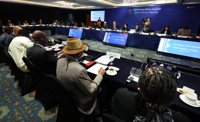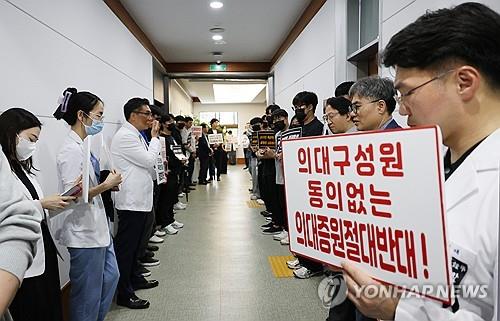(Yonhap Interview) U.S. Army Pacific commander says SM-6, Tomahawk missile launchers to be deployed in Indo-Pacific
By Kim Eun-jung
PYEONGTAEK, South Korea, April 7 (Yonhap) -- The United States will deploy ground-based launchers capable of firing SM-6 and Tomahawk missiles in the Indo-Pacific region soon to address rising security threats, the Army Pacific commander has said.
During his visit to South Korea, Gen. Charles Flynn said the U.S. Army has developed "long-range precision fires," listing the SM-6 interceptor and the maritime-strike Tomahawk as missiles that could be launched from the new launch system.
It marks his first confirmation of the types of weapons systems to be fielded in the region this year.
"That system will be deploying into the region soon. Where and when it's going to go, I'm not going to talk about that now," Flynn said during the interview with Yonhap News Agency at Camp Humphreys in Pyeongtaek, 60 kilometers south of Seoul, on Saturday.
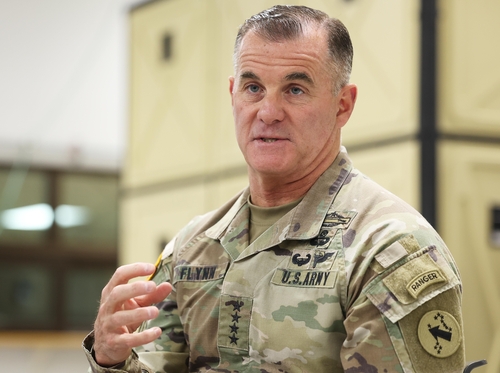
Gen. Charles Flynn, the commanding general of U.S. Army Pacific, speaks during an interview with Yonhap News Agency at Vandal Training Center in Camp Humphreys in Pyeongtaek, 60 kilometers south of Seoul, on April 6, 2024. (Yonhap)
The SM-6 is designed to intercept ballistic missiles with a range of over 240 km, and the Tomahawk is a subsonic cruise missile that can strike a target about 2,500 km away.
Experts widely speculate the system could be the ground-based Typhon system, which has been operated by the U.S. Army since last year. Guam, a U.S. territory in the Western Pacific Ocean, is considered a potential site for the system, according to Japanese media.
It marks a significant development as such a weapon system would be deployed in the region for the first time since the U.S. and the former Soviet Union signed a treaty in 1987 to abolish the Intermediate-Range Nuclear Forces (INF).
After the U.S. withdrew from the INF treaty in 2019, citing alleged Russian violations, the U.S. Army has developed and deployed new intermediate-range missiles amid China's muscle-flexing in the Indo-Pacific region.
Flynn, who was on a three-nation Asia tour, including stops in Japan and Thailand, addressed concerns over North Korea's recent string of missile tests but showed confidence in the alliance's "integrated and layered missile defense system."
"Continued testing is concerning and, in many ways, destabilizing," he said. "I am confident, given our recent activities in the region, about layered missiles defense of what we have."
North Korea said Wednesday it test-fired a new hypersonic intermediate-range ballistic missile, called the Hwasongpho-16B, claiming all of its missiles are now solid-fuel and nuclear capable with warhead control capability.
A hypersonic missile is usually hard to intercept with existing missile defense shields as it can travel at five times the speed of sound, changes its flight paths and flies at low altitudes.
The U.S. Forces Korea operates low-tier PAC-3 missiles and the upper-tier Terminal High Altitude Area Defense (THAAD) interceptors. The U.S. missile shield is complemented by South Korea's homegrown surface-to-air missile (M-SAM) defense system, called Cheongung, against mid-tier threats.

Gen. Charles A. Flynn (R), commander of the U.S. Army Pacific, and Defense Minister Shin Won-sik pose for a photo after Flynn received a state medal from the South Korean government for his contributions to the bilateral alliance at the defense ministry's headquarters in central Seoul on April 4, 2024, in this photo provided by the defense ministry. (PHOTO NOT FOR SALE) (Yonhap)
The top commander of the U.S. Army's largest component also highlighted potential risks associated with North Korea's supplying of arms to Russia for its ongoing conflict in Ukraine.
Seoul officials have raised concerns over Pyongyang advancing its weapons programs with the help of Moscow in return for supplying thousands of containers carrying munitions and other weapons since last year.
"More concerning, though, is the fact that North Korean capabilities are being used by the Russians in that laboratory on the battlefield," he said. "To me, that is an area that we are going to continue to watch."
Flynn lauded the South Korean Army for going beyond its territory to join multinational drills with the U.S. and its allies abroad, believing it sends "an important message" to the broader region amid rising security challenges posed by China.
"They are also projecting that alliance into the region at a time when we absolutely need our friends and allies across the region to be together so we can be a counterweight to some of the irresponsible and insidious behavior of China," he said.
The four-star general, whose father previously served in South Korea, said he feels grateful to see the progress that the South Korean military and Army have made over the decades and the long-standing alliance between the two countries.
"For two generations now, my father's generation and my generation, being able to bring those experiences and see the gains that have been made since the late '90s to now, it's pretty dramatic," Flynn said.
ejkim@yna.co.kr
(END)
-
 BTS' RM to prerelease a track of 2nd solo album
BTS' RM to prerelease a track of 2nd solo album -
 'Queen of Tears' weaves rich tapestry of Korean contemporary art
'Queen of Tears' weaves rich tapestry of Korean contemporary art -
 From pastime to academic discipline: Exhibition spotlights evolution of Korean embroidery
From pastime to academic discipline: Exhibition spotlights evolution of Korean embroidery -
 Indonesia coach left with mixed feelings after eliminating native S. Korea in Olympic football qualifiers
Indonesia coach left with mixed feelings after eliminating native S. Korea in Olympic football qualifiers -
 N. Korea calls envisioned U.S. aid to Ukraine 'hallucinogen'
N. Korea calls envisioned U.S. aid to Ukraine 'hallucinogen'
-
 'Queen of Tears' weaves rich tapestry of Korean contemporary art
'Queen of Tears' weaves rich tapestry of Korean contemporary art -
 From pastime to academic discipline: Exhibition spotlights evolution of Korean embroidery
From pastime to academic discipline: Exhibition spotlights evolution of Korean embroidery -
 BTS' RM to prerelease a track of 2nd solo album
BTS' RM to prerelease a track of 2nd solo album -
 Looming weekly closure of major hospitals feared to worsen medical service crisis
Looming weekly closure of major hospitals feared to worsen medical service crisis -
 N. Korea calls envisioned U.S. aid to Ukraine 'hallucinogen'
N. Korea calls envisioned U.S. aid to Ukraine 'hallucinogen'
-
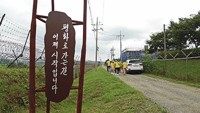 Gov't to open 10 trails near DMZ for visitors next month
Gov't to open 10 trails near DMZ for visitors next month -
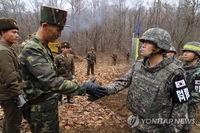 N. Korea installs mines on inter-Korean road within DMZ
N. Korea installs mines on inter-Korean road within DMZ -
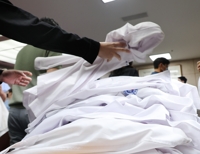 Two major hospitals in Seoul set to suspend outpatient clinics, surgeries
Two major hospitals in Seoul set to suspend outpatient clinics, surgeries -
 NIS sees possibility of N. Korean terrorist attacks involving drones, paragliders
NIS sees possibility of N. Korean terrorist attacks involving drones, paragliders -
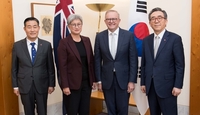 (LEAD) S. Korean ministers, Australian PM agree to enhance security, defense industry cooperation
(LEAD) S. Korean ministers, Australian PM agree to enhance security, defense industry cooperation
















